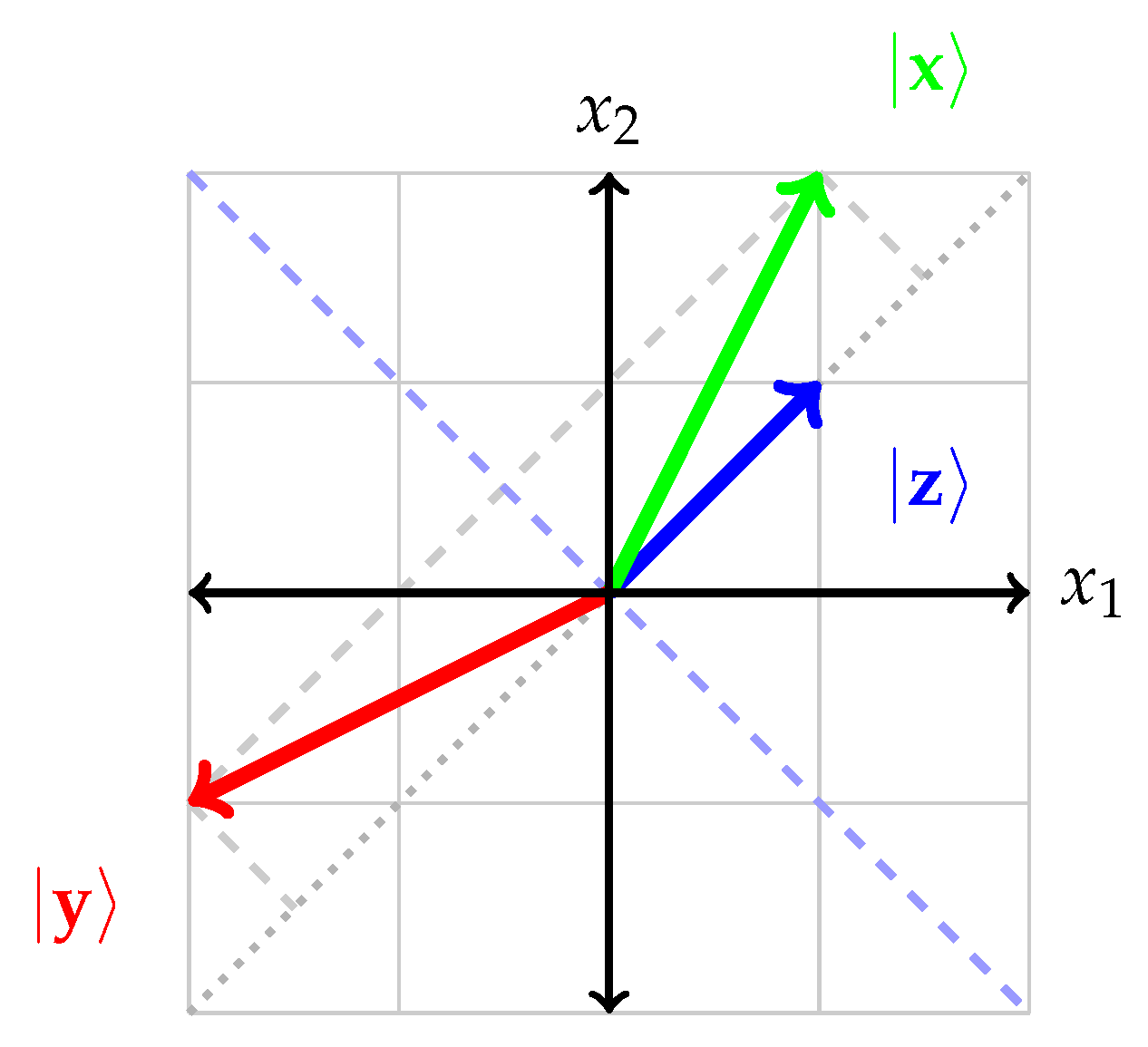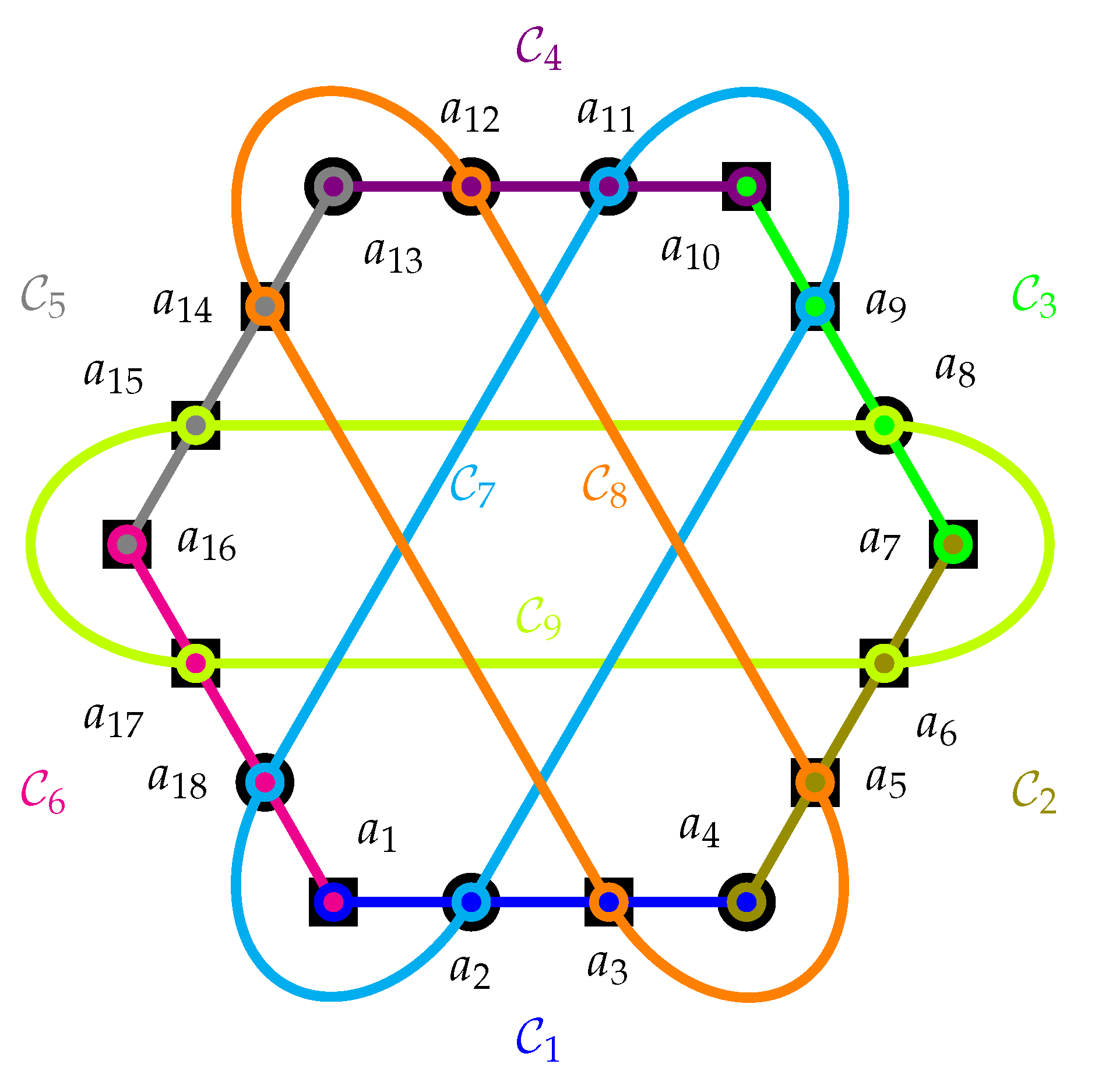Generalized Householder Transformations
Abstract
1. From probabilities to expectations
- (i)
- is Hermitian; that is, ;
- (ii)
- is unitary, that is,
- (iii)
- Hence, is involutory: ;
- (iv)
- The eigensystem of has two eigenvalues :
- :
- For the eigenvector of , with , the associated eigenvalue is ;
- :
- The remaining mutually orthogonal eigenvectors span the -dimensional subspace orthogonal to . Every vector in that subspace has eigenvalue . (For , the spectrum is degenerate.)
Stated differently, for all vectors orthogonal to , the Householder transformation acts as the identity; for , the Householder transformation acts as a reflection on the one-dimensional subspace spanned by ; - (v)
- Since the determinant of a matrix is the product of its eigenvalues, the determinant of a Householder transformation is ;
- (vi)
- If is an orthonormal basis formalizing a context, then the succession of the respective Householder transformations renders negative unity, that is,
2. Generalized Operator-Valued Arguments for Mixed States
3. Generalized Operations
4. Applications beyond the Quantum Domain
5. Summary
Funding
Data Availability Statement
Acknowledgments
Conflicts of Interest
References
- Murnaghan, F.D. The Unitary and Rotation Groups; Lectures on Applied Mathematics; Spartan Books: Washington, DC, USA, 1962; Volume 3. [Google Scholar]
- Horn, R.A.; Johnson, C.R. Matrix Analysis, 2nd ed.; Cambridge University Press: New York, NY, USA, 2013. [Google Scholar]
- Cabello, A. Experimentally Testable State-Independent Quantum Contextuality. Phys. Rev. Lett. 2008, 101, 210401. [Google Scholar] [CrossRef]
- Badzia̧g, P.; Bengtsson, I.; Cabello, A.; Pitowsky, I. Universality of State-Independent Violation of Correlation Inequalities for Noncontextual Theories. Phys. Rev. Lett. 2009, 103, 050401. [Google Scholar] [CrossRef]
- Abbott, A.A.; Calude, C.S.; Svozil, K. A variant of the Kochen-Specker theorem localising value indefiniteness. J. Math. Phys. 2015, 56, 102201. [Google Scholar] [CrossRef]
- Cabello, A.; Estebaranz, J.M.; García-Alcaine, G. Bell-Kochen-Specker theorem: A proof with 18 vectors. Phys. Lett. A 1996, 212, 183–187. [Google Scholar] [CrossRef]
- Waegell, M.; Aravind, P.K.; Megill, N.D.; Pavičić, M. Parity Proofs of the Bell-Kochen-Specker Theorem Based on the 600-cell. Found. Phys. 2011, 41, 883–904. [Google Scholar] [CrossRef]
- Pavicic, M. Arbitrarily exhaustive hypergraph generation of 4-, 6-, 8-, 16-, and 32-dimensional quantum contextual sets. Phys. Rev. A 2017, 95, 062121. [Google Scholar] [CrossRef]
- Pavičić, M.; Megill, N.D. Vector Generation of Quantum Contextual Sets in Even Dimensional Hilbert Spaces. (Program code available online: https://puh.srce.hr/s/Qegixzz2BdjYwFL). Entropy 2018, 20, 928. [Google Scholar] [CrossRef]
- Greenberger, D.M.; Horne, M.A.; Zeilinger, A. Going beyond Bell’s theorem. In Bell’s Theorem, Quantum Theory, and Conceptions of the Universe; Kafatos, M., Ed.; Fundamental Theories of Physics; Kluwer Academic Publishers, Springer: Dordrecht, The Netherlands, 1989; Volume 37, pp. 69–72. [Google Scholar] [CrossRef]
- Svozil, K. Generalized Greenberger-Horne-Zeilinger Arguments from Quantum Logical Analysis. Found. Phys. 2022, 52, 4. [Google Scholar] [CrossRef]
- Yu, X.D.; Guo, Y.Q.; Tong, D.M. A proof of the Kochen-Specker theorem can always be converted to a state-independent noncontextuality inequality. New J. Phys. 2015, 17, 093001. [Google Scholar] [CrossRef][Green Version]
- Kochen, S.; Specker, E.P. The Problem of Hidden Variables in Quantum Mechanics. J. Math. Mech. (Now Indiana Univ. Math. J.) 1967, 17, 59–87. [Google Scholar] [CrossRef]
- Shekarriz, M.H.; Svozil, K. Noncontextual coloring of orthogonality hypergraphs. arXiv 2021, arXiv:2105.08520. [Google Scholar]
- Lovász, L. On the Shannon capacity of a graph. IEEE Trans. Inf. Theory 1979, 25, 1–7. [Google Scholar] [CrossRef]
- Lovász, L.; Saks, M.; Schrijver, A. Orthogonal representations and connectivity of graphs. Linear Algebra Appl. 1989, 114–115, 439–454. [Google Scholar] [CrossRef]
- Solís-Encina, A.; Portillo, J.R. Orthogonal Representation of Graphs. arXiv 2015, arXiv:1504.03662. [Google Scholar]
- Halmos, P.R. Finite-Dimensional Vector Spaces; Undergraduate Texts in Mathematics; Springer: New York, NY, USA, 1958. [Google Scholar] [CrossRef]
- von Neumann, J. Über Funktionen von Funktionaloperatoren. Ann. Math. 1931, 32, 191–226. [Google Scholar] [CrossRef]
- Godsil, C.D.; Zaks, J. Colouring the Sphere. arXiv 2012, arXiv:1201.0486. [Google Scholar]
- Meyer, D.A. Finite precision measurement nullifies the Kochen-Specker theorem. Phys. Rev. Lett. 1999, 83, 3751–3754. [Google Scholar] [CrossRef]
- Havlicek, H.; Krenn, G.; Summhammer, J.; Svozil, K. Colouring the rational quantum sphere and the Kochen-Specker theorem. J. Phys. A Math. Gen. 2001, 34, 3071–3077. [Google Scholar] [CrossRef]
- Godsil, C.D.; Newman, M.W. Coloring an Orthogonality Graph. SIAM J. Discret. Math. 2008, 22, 683–692. [Google Scholar] [CrossRef]
- Bohr, N. Discussion with Einstein on epistemological problems in atomic physics. In Albert Einstein: Philosopher-Scientist; Schilpp, P.A., Ed.; The Library of Living Philosophers: Evanston, IL, USA, 1949; pp. 200–241. [Google Scholar] [CrossRef]
- Khrennikov, A. Bohr against Bell: complementarity versus nonlocality. Open Phys. 2017, 15, 734–738. [Google Scholar] [CrossRef]
- Jaeger, G. Quantum contextuality in the Copenhagen approach. Philos. Trans. R. Soc. A Math. Phys. Eng. Sci. 2019, 377, 20190025. [Google Scholar] [CrossRef]
- Peres, A. Unperformed experiments have no results. Am. J. Phys. 1978, 46, 745–747. [Google Scholar] [CrossRef]
- Svozil, K. How much contextuality? Nat. Comput. 2012, 11, 261–265. [Google Scholar] [CrossRef][Green Version]
- Dzhafarov, E.N.; Cervantes, V.H.; Kujala, J.V. Contextuality in canonical systems of random variables. Philos. Trans. R. Soc. A Math. Phys. Eng. Sci. 2017, 375, 20160389. [Google Scholar] [CrossRef]
- Abramsky, S. Contextuality: At the Borders of Paradox. In Categories for the Working Philosopher; Landry, E., Ed.; Oxford University Press: Oxford, UK, 2018; pp. 262–285. [Google Scholar] [CrossRef]
- Grangier, P. Contextual objectivity: A realistic interpretation of quantum mechanics. Eur. J. Phys. 2002, 23, 331–337. [Google Scholar] [CrossRef][Green Version]
- Jaeger, G. Quantum Contextuality and Indeterminacy. Entropy 2020, 22, 867. [Google Scholar] [CrossRef]
- Aufféves, A.; Grangier, P. Extracontextuality and extravalence in quantum mechanics. Philos. Trans. R. Soc. A Math. Phys. Eng. Sci. 2018, 376, 20170311. [Google Scholar] [CrossRef]
- Auffèves, A.; Grangier, P. Deriving Born’s Rule from an Inference to the Best Explanation. Found. Phys. 2020, 50, 1781–1793. [Google Scholar] [CrossRef]
- Grangier, P. Completing the quantum formalism in a contextually objective framework. arXiv 2020, arXiv:2003.03121. [Google Scholar] [CrossRef]
- Budroni, C.; Cabello, A.; Gühne, O.; Kleinmann, M.; Larsson, J.A. Quantum Contextuality. arXiv 2021, arXiv:2102.13036. [Google Scholar]
- Svozil, K. Varieties of contextuality based on probability and structural nonembeddability. arXiv 2021, arXiv:2103.06110. [Google Scholar]


Publisher’s Note: MDPI stays neutral with regard to jurisdictional claims in published maps and institutional affiliations. |
© 2022 by the author. Licensee MDPI, Basel, Switzerland. This article is an open access article distributed under the terms and conditions of the Creative Commons Attribution (CC BY) license (https://creativecommons.org/licenses/by/4.0/).
Share and Cite
Svozil, K. Generalized Householder Transformations. Entropy 2022, 24, 429. https://doi.org/10.3390/e24030429
Svozil K. Generalized Householder Transformations. Entropy. 2022; 24(3):429. https://doi.org/10.3390/e24030429
Chicago/Turabian StyleSvozil, Karl. 2022. "Generalized Householder Transformations" Entropy 24, no. 3: 429. https://doi.org/10.3390/e24030429
APA StyleSvozil, K. (2022). Generalized Householder Transformations. Entropy, 24(3), 429. https://doi.org/10.3390/e24030429





